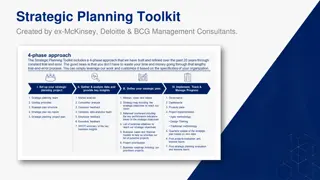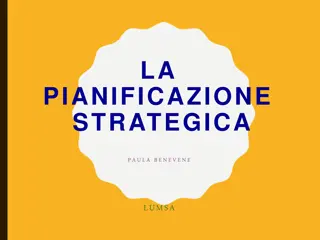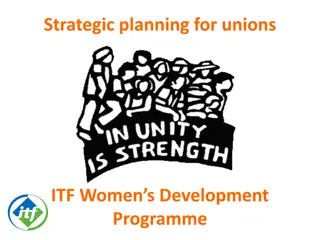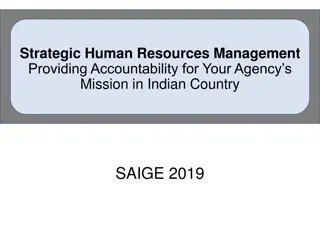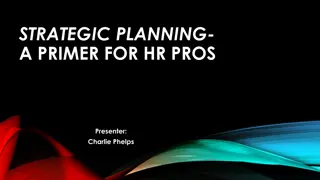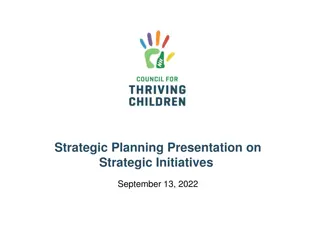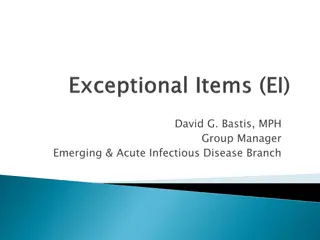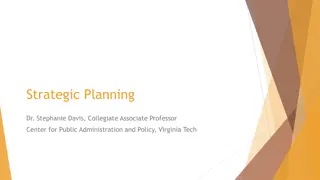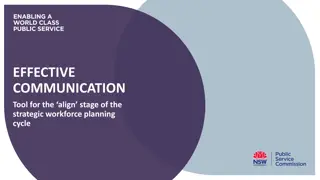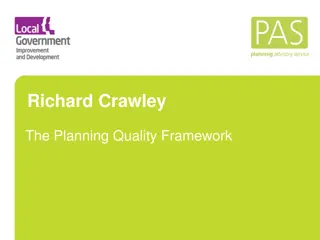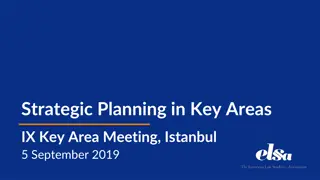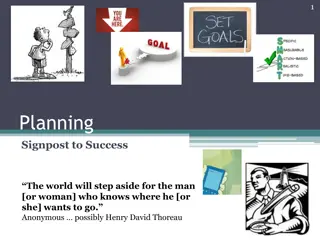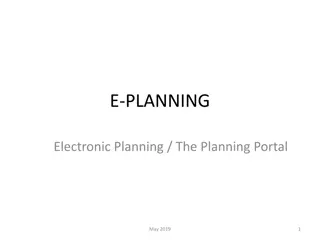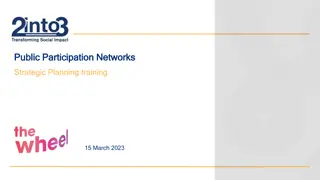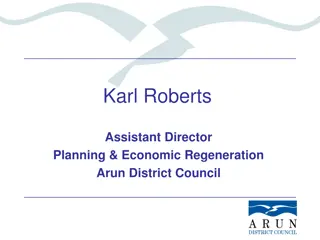
Strategic Plan Development Process in Higher Education Institutions
Explore the detailed process behind the development of a strategic plan in higher education institutions, involving key stakeholders such as the Board of Trustees, classified staff, and academic senates. Follow the timeline from drafting mission statements to plan implementation and evaluation for effective institutional growth.
Uploaded on | 3 Views
Download Presentation

Please find below an Image/Link to download the presentation.
The content on the website is provided AS IS for your information and personal use only. It may not be sold, licensed, or shared on other websites without obtaining consent from the author. If you encounter any issues during the download, it is possible that the publisher has removed the file from their server.
You are allowed to download the files provided on this website for personal or commercial use, subject to the condition that they are used lawfully. All files are the property of their respective owners.
The content on the website is provided AS IS for your information and personal use only. It may not be sold, licensed, or shared on other websites without obtaining consent from the author.
E N D
Presentation Transcript
1 2014 STRATEGIC PLAN DEVELOPMENT
2 2014 Strategic Plan STRATEGIC PLANNING IS A TEAM EFFORT Board of Trustees Classified Staff Chancellor s Cabinet ALL CONSTITUENCY Faculty DSPC GROUPS Academic Senates Colleges District Office
3 2014 Strategic Plan 2013-14 Committee Members: San Bernardino Valley College Gloria Fisher Gloria Fisher Interim President SBVC Algie Au Algie Au Faculty SBVC Academic Senate Greg Zerovnik Greg Zerovnik Public Information Officer SBVC James Smith James Smith Research SBVC Jimmie Bradley Jimmie Bradley Student SBVC Laura Gowen Laura Gowen Classified Staff SBVC Rania Hamdy Rania Hamdy Professional Development SBVC
4 2014 Strategic Plan 2013-14 Committee Members: Crafton Hills College Cheryl Marshall Cheryl Marshall President CHC Chris Robles Chris Robles Student CHC Denise Allen Hoyt Denise Allen Hoyt Faculty CHC Academic Senate Donna Hoffmann Donna Hoffmann Public Information Officer CHC Keith Wurtz Keith Wurtz Research CHC Robert Brown Robert Brown Professional Development CHC Tina Gimple Tina Gimple Classified Staff CHC
5 2014 Strategic Plan 2013-14 Committee Members: District Office, TESS, EDCT, KVCR Bruce Baron Bruce Baron Chancellor District Tim Oliver Tim Oliver Interim Vice Chancellor FS District Amalia Perez Amalia Perez for Vice Chancellor HR District Glen Kuck Glen Kuck Assoc. Vice Chancellor TESS Deanna Trussell Deanna Trussell for Exec Director, EDCT EDCT Lillian Vasquez Lillian Vasquez General Manager Appointee KVCR Barbara Nichols Barbara Nichols Classified Staff District Sites (KVCR) Charlie Ng Strategic Plan Facilitator Charlie Ng Strategic Plan Facilitator
6 2014 Strategic Plan Plan Status 1 Get ready, planning for strategic planning DSPC Complete 2 Draft mission, vision, values DSPC Complete 3 Assess situation Gather strengths, weaknesses, opportunities, and threats (SWOT) and environmental scan information Discuss draft mission, vision, values, SWOT, and environmental scan information and goals DSPC Complete Board of Trustees DSPC Complete Complete 4 Agree on priorities, integrate with campus plans Board of Trustees DSPC DSPC District Staff Complete Complete March 2014 April 2014 Make sense of the data Draft goals Draft strategies Campus review and input 5 Draft final plan (mission, vision, values, goals, and strategies) and submit to BOT for approval DSPC TBD 6 Implement plan Develop annual operating plan District Staff TBD 7 Evaluate and monitor strategic plan Board of Trustees District Staff Fall 2015
7 2014 Strategic Plan Definition of Environmental Scan An Environmental Scan is generally defined as a collection of strategic information about the College s service area or external setting in which it functions. Study of this external setting includes such factors as its resident population, community college students, businesses, competitive educational institutions, local and regional labor market, and local and regional economic context.
8 2014 Strategic Plan Benefits of an Environmental Scan 1. Ability to better meet the College s Economic Development Mission 2. Better informed with regard to the local and regional economies 3. Being more agile and market responsive in terms of curriculum planning 4. Identifying the location of current and future job markets 5. Identifying demand by highest growth and highest paying jobs 6. Help meet programmatic, grant, and State reporting requirements
9 2014 Strategic Plan Benefits of an Environmental Scan 7. Help meet programmatic, grant, and State reporting requirements 8. Identifying opportunities for fee-based courses 9. Better identifying and targeting of potential student markets by population, age, ethnicity, educational attainment, etc. 10.Better identifying the competition (private and public institutions) 11. Compiling compelling data useful in competing for Federal Grants and execution of Bond Issue Campaigns 12. Identifying potential business partners for training programs
10 2014 Strategic Plan Benefits of an Environmental Scan 13. Identifying small businesses (by employees and sales) 14. Conducting small area analysis at the zip code level 15. Comparing selected metrics of competitive community colleges 16. Providing baseline data for Strategic Reports 17. Providing baseline demographic information for diversity compliance
11 2014 Strategic Plan Environmental Scan Components 1. 2. 3. 4. 5. 6. 7. 8. 9. 10. Study Area District Fiscal Abstract Data 11. Success Scorecard 12. Sample Uses of Environmental Scan Data a) Researching an Industry or Sector b) Sample Analysis Comparative Analysis- TOP Code Health c) Analysis by Geography 13. Appendix Study Areas Demographics Educational Characteristics Resident Labor Force Community Colleges and Students San Bernardino and Riverside Counties Private Schools Possible Competition Establishments San Bernardino and Riverside Counties Jobs Projections by Industry Jobs Projections by Occupation
12 2014 Strategic Plan Environmental Scan Example: SBVC Capture Rate by ZIP Code
13 2014 Strategic Plan STRUCTURE I. II. III. IV. Major Goals Sub-Goals V. Addendum Resources Necessary to Achieve Goals Ethnic and Cultural Diversity Mission Vision Values Strategies
14 2014 Strategic Plan Draft Mission We transform lives through education of our students for the benefit of our diverse communities.
15 2014 Strategic Plan Draft Vision SBCCD will be most known for student success. 1. Our educational programs and services will be highly sought after. 2. Our students will be the most sought after by four-year institutions and employers. 3. Our transfer students will have the highest graduation rates at four- year institutions. 4. Our students will have the highest employment rates in our communities.
16 2014 Strategic Plan Draft Vision (continued) 5. Our district will be the gateway to pathways and opportunities for a brighter future. 6. Our students and alumni will make the largest contribution to the economic prosperity of our communities. 7. Our employees will want to be here, love working here, and go above and beyond for student success.
17 2014 Strategic Plan Draft Values Service, Integrity, Collaboration, Innovation, Quality
18 2014 Strategic Plan MAJOR GOALS Goal 1: Student Success Provide the programs and services necessary to enable all students to achieve their educational and career goals. Goal 2: Enrollment and Access Increase access to higher education for growing populations in our region.
19 2014 Strategic Plan MAJOR GOALS Goal 3: Partnerships of Strategic Importance Invest in strategic relationships and collaborate with partners in higher education, PK-12 education, business and workforce development, government, and other community organizations. Goal 4: District Operational Systems Improve the district systems to increase administrative and operational efficiency and effectiveness.
20 2014 Strategic Plan Goal 1: Student Success Provide the programs and services necessary to enable all students to achieve their educational and career goals. GOAL 1.1 Increase student success while preserving access, enhancing quality, and eradicating attainment gaps associated with income, race, ethnicity, age, and gender. Goals Graduation Rate Transfer Rate Job Placement Rate % with Educational Plan Student Goal Completion Rate 2013-14 2016-17 2019-20 Key Strategies (Examples) Strategy 1: Decrease time to complete degree or certificate Strategy 2: Improve student satisfaction/campus climate survey results Strategy 3: Increase student engagement
21 2014 Strategic Plan GOAL 1.2 Increase the number of students who complete developmental education programs and progress to successful completion of freshman-level courses. Development Education Improvement Rates 2013-14 2016-17 2019-20 Math English Reading ESL Key Strategies: To be determined
22 2014 Strategic Plan Goal 2: Enrollment and Access Increase access to higher education for growing populations in our region. GOAL 2.1 Increase our student population to improve the higher education participation rate and supply a well-equipped, educated workforce for our communities. Student Population Goals Annual Enrollment Adult Participation Rate 2013-14 2016-17 2019-20 Key Strategies (Examples) Strategy 1: Increase international student enrollment. Strategy 2: Increase marketing and outreach activities
23 2014 Strategic Plan GOAL 2.2 Provide transfer, career and technical, and developmental education access to meet student need. Enrollment by Type of Education Transfer Career and Technical Developmental 2013-14 2016-17 2019-20 Note: The outcome measures will be the percentage of students who have access to the transfer/CTE/developmental education that students need based on placement information. Key Strategies (Examples) Strategy 1: This should be reflective of emerging trends. Strategy 2: Invest in (a determined) program (or discipline)
24 2014 Strategic Plan GOAL 2.3 Enhance the public image of the San Bernardino Community College District. Key Strategies (Examples) Strategy 1: Utilize KVCR and EDCT as resources to enhance public image Strategy 2: Assess public image (polling services), develop and implement plan based on assessment results
25 2014 Strategic Plan GOAL 2.4 Increase awareness of San Bernardino Valley College and Crafton Hills College as viable higher education options. Key Strategies (Examples) Strategy 1: Easy access. Strategy 2: Develop community college campaigns to showcase at local high schools
26 2014 Strategic Plan GOAL 2.5 Strive to diversify our student and employee populations to be reflective of our communities. Key Strategies (Examples) Strategy 1: Market and outreach to student populations that are reflective of emerging trends
27 2014 Strategic Plan Goal 3: Partnerships of Strategic Importance Invest in strategic relationships and collaborate with partners in higher education, PK-12 education, business and workforce development, government, and other community organizations. GOAL 3.1 Enhance existing and secure new higher education partnerships to improve student transfers rates. Key Strategies Strategy 1: Enhance developmental course curriculum. Strategy 2: Create a consortium of higher education partners to focus on improving student transfer rates.
28 2014 Strategic Plan GOAL 3.2 Enhance existing and secure new PK-12 partnerships to improve student pathways, increase awareness of SBVC and CHC as viable options for higher education, and enhance the image of the San Bernardino Community College District. Key Strategies Strategy 1: Enhance developmental course curriculum. Strategy 2: Work with PK-12 partners to develop a communications campaign with the intent on sharing with local high school students and parents
29 2014 Strategic Plan GOAL 3.3 Enhance existing and secure new business and workforce development partnerships for student internship opportunities, student pathways, incumbent worker training, and to enhance career and technical education course curriculum. Key Strategies Strategy 1: Work with industry partners with a history of utilizing student interns and develop internship opportunities for SBCCD students Strategy 2: Develop an internship program template that makes it attractive for business partners to enter student interns into their workforce and market the program to local businesses
30 2014 Strategic Plan GOAL 3.4 Enhance existing and secure new government and community partnerships to increase funding for improving student success, and increasing student access. Key Strategies Strategy 1: Partner with other local community colleges to advocate for community college funding Strategy 2: Attempt to consistently have a representative from the district serve in state-level leadership roles (CCLC, ACBO, etc.) Strategy 3: Work with lobby services (CCLC, SSC, etc.) to remain current on funding issues and to provide feedback to local and state government officials in pursuing funding opportunities
31 2014 Strategic Plan Goal 4: District Operational Systems Improve the district systems to increase administrative and operational efficiency and effectiveness. GOAL 4.1 Improve the district systems to increase administrative and operational efficiency and effectiveness with an emphasis on student records, human resources, facilities, technology, financial systems, and other workflow operational systems. Key Strategies Strategy 1: Align policies. Strategy 2: Conduct a business process analysis. Strategy 3: Streamline procedures with the district s strategic plan. Strategy 4: Improve communications throughout the district. Strategy 5: Integrate major enterprise resource programs.
32 2014 Strategic Plan ADDENDUM Resources Necessary to Achieve Strategic Goals Examples: Funding for Increased Access and Student Success Increase the number of grants and contributions from foundations. (source: DSPC-opportunities) Alignment of Budget Priorities with District Strategic Plan Resource Optimization
33 2014 Strategic Plan ADDENDUM Ethnic and Cultural Diversity Examples: SBCCD supports the inherent dignity of all individuals and celebrates their diversity. We support the concepts of inclusiveness and equity for students and employees. We extend the privileges of academic life to all by promoting the application of fair and ethical practices and policies.


